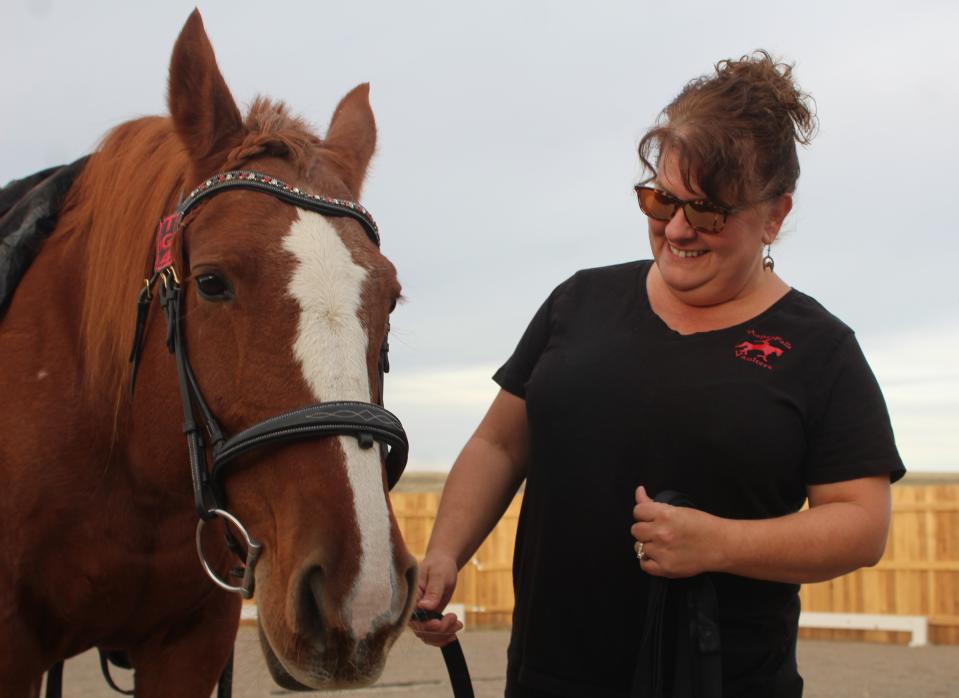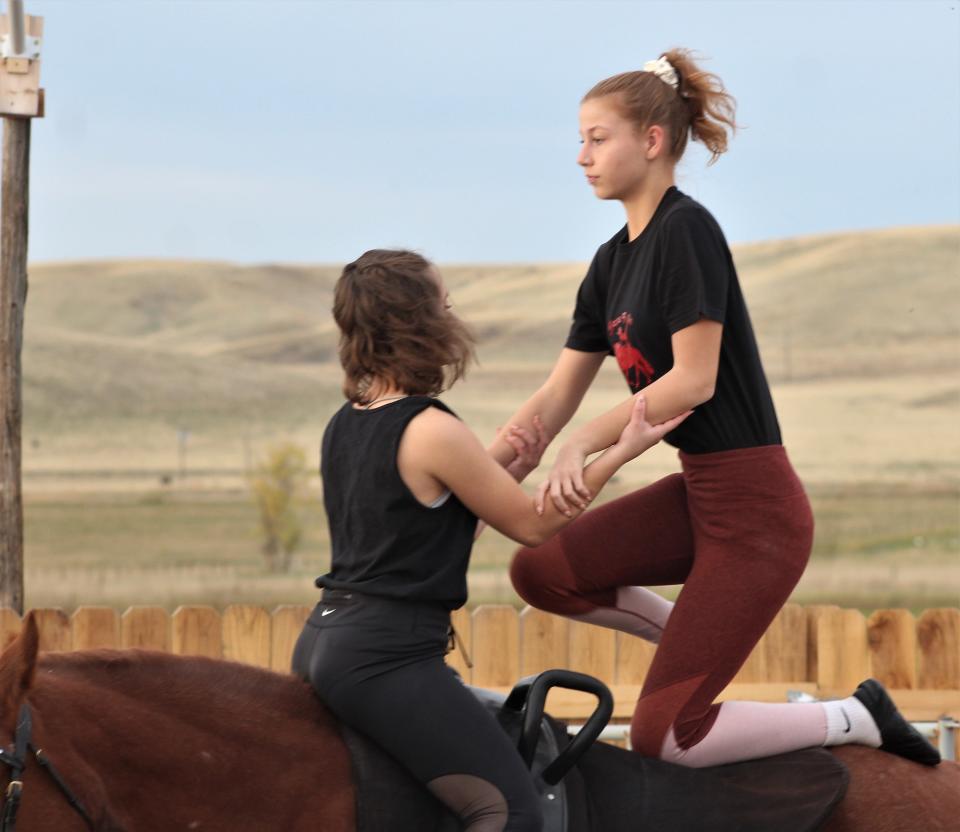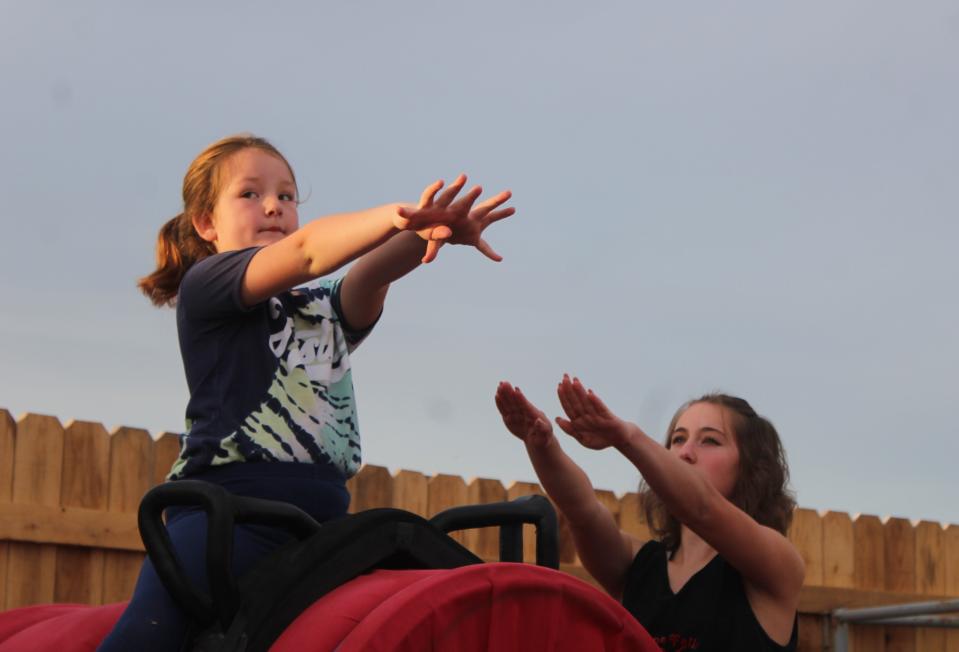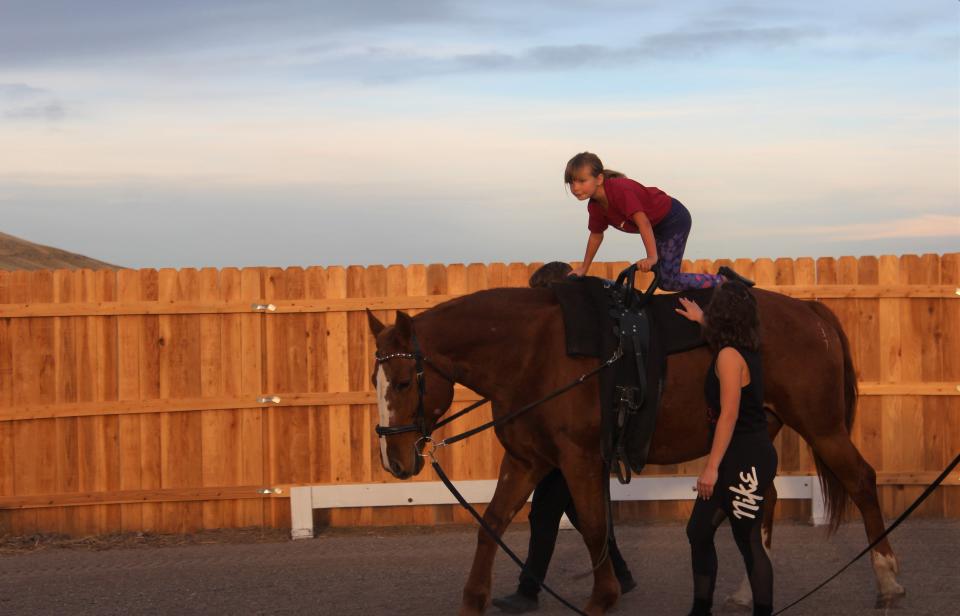Vaughn family trains, coaches, competes at Montana's first equestrian vaulting club
It’s hard to live in Montana and be unaware of how important horsemanship is to the state’s culture. Events like barrel racing, calf roping, and bronc riding are a fixture of every county fair, and tens of thousands of Montana families are deeply involved in riding and showing horses through organizations like 4-H and local riding clubs.
However, it’s likely that far fewer Montanans are familiar with the sport of equestrian vaulting. Equestrian vaulting is a combination of dance and gymnastics performed on horseback. It blends human strength and artistry with a deep and intensive connection to the horse they perform on. It isn’t trick riding, its more like a ballet in which human and horse are equal partners.
The sport can be either competitive or non-competitive, and has a long history in Europe. Equestrian vaulting was once an Olympic sport but wasn’t introduced to the United States until the late 1960s. According to Equestrian Vaulting USA (EVUSA) there are now more than 140 vaulting clubs in states from Alaska to Florida, and more than 1,400 vaulting club members in Canada and the U.S.
Montana has just one registered equestrian vaulting club, and it lies just west of Vaughn at the home of Gina and Marshall Fiedler.

“The thing with vaulting is you want to become in harmony with your horse,” said Gina Fiedler as she slowly guided her horse Oakley around the confines a circular arena. Nearby, members of the Hope Falls Vaulting Club limber up in preparation for a class of young, novice vaulters who are about to arrive.
In one hand Fiedler holds a long lead rope called a “lunge line” that is attached to Oakley’s harness. In the other she holds a very long “whip,” which in actual terms is more like a long piece of cotton twine attached to a flexible fiberglass rod. Fiedler guides Oakley around the arena at a slow trot, occasionally draping the whip’s lash across the horse’s haunches. Every few seconds she emits a click, a kissing sound, or a loud trill in communication with Oakley.
“Vaulting horses are not cued the same way that Western or English riding horses are,” Fiedler explains. “It’s one click for walk, two for trot, a kiss is for cantor and then the (trill) is how I tell her to slow down. I will wiggle or do things with the lunge line that’s connected to her bit and we also have the whip to help her to understand. She doesn’t get hit with it. It’s very light. She just feels it a little bit. She knows cues that we use with that as well, and that’s how we communicate with her.”
On her back, Oakley wears what’s called a surcingle saddle specifically designed for vaulting competition. Instead of a stiffened seat for a rider to sit upon the surcingle saddle has a soft platform that drapes across the horse’s withers and back. Two secured handles extend from the saddle which the vaulters use to perform with. In some ways, it resembles a pommel horse attached to the back of a living one.
As Fiedler brings Oakley to a halt, competitive vaulters Alexis Fiedler and Hannah Hildebrand swing themselves onto the horse’s back. With Gina once again guiding Oakley in a slow circular pace, Alexis and Hannah move gracefully across the horse's back, turning and extending, standing and supporting each other as Oakley moves around the arena. Their movements are not random but rather a choreographed routine that in competition is set to music.

The athletes do not hold any reins but offer the horse subtle cues with the tip of a toe or the inside of their leg. Staying focused and in harmony with the horse is a key element of equestrian vaulting.
“You learn how she’s moving no matter what gait she’s at and you find center on her,” Gina explained. “That’s what keeps you in harmony with her.”
Horses, dance, and gymnastics were all important parts of Gina Fiedler’s life growing up, but she only heard of equestrian vaulting three years ago. She was introduced to the sport at a local clinic that featured Todd Griffiths, a former member of the U.S. Vaulting Team who has competed in equestrian competitions in the U.S., Canada, France, Hungary, and Sweden.
Griffiths is the brother of Jessica Fryberger, owner of the 406 Arena in Vaughn. Fryberger founded the vaulting club and began offering classes. In 2020, the Fiedler children were introduced to equestrian vaulting and began attending classes.
"Jessica at the 406 did own and start it, and was coaching," Fiedler explained. "Her brother Todd, came, did clinics and trained. They needed more coaches and my kids were attending the classes and loving it so I said I would coach, but knew nothing of it and needed Todd to teach me."
“He came back and held quite a few clinics,” she added of her training under Todd Griffiths. “He taught me how to coach. He taught my children how to coach as well. I coached the vaulting club at the 406, for about 1-1/2 years, until Jessica sold it to us."
The Hope Falls Equestrian Club is now a registered member of Equestrian Vaulting USA, an affiliated association of the United States Equestrian Foundation which trains, selects and funds the U.S. Olympic Equestrian Team.
All four of the Fiedler children are members of the Hope Falls Vaulting Club’s competitive vaulting teams and have now traveled to competitions in Oregon, Washington and Utah. Since vaulting is a team sport, as well as an individual one, not every athlete brings their own horse. The Fielders have four horses but typically travel with only two, one as their competition horse and another companion animal.
Though new, the Hope Falls Vaulting Club has already experienced a great deal of success in competition.
“Last year five of our kids qualified for nationals,” Fiedler said, “so we went to the Equestrian Vaulting in Rancho Murieta, California.”
The vaulting championship just east of Sacramento featured top vaulters from across the U.S. Fourteen-year-old James Fiedler came away a national championship in the One Star Trot Men’s Division. He said he loves the sport because of its combination of gymnastics and trained horsemanship.
“It’s like doing two sports at the same time, so it’s almost better than both,” he said.

When they’re not competing the Fieders operate a growing business offering equestrian vaulting classes to students. The Hope Falls Vaulting Club now consists of more than 40 students, mostly teen and pre-teen girls, but with a scattering of boys too.
“We have classes for students from ages four up to 18 right now,” Gina Fiedler said.
If the thought of a five- or six-year-old doing tricks on the back of a moving horse seems unnerving, it’s important to remember that vaulting is always done in a very controlled environment. Training and competition occur in a fully enclosed arena, in a consistently large circle with soft footing, and with the horse attached to a lunge line controlled by a trainer. Students train on mats and on a stationary vaulting barrel long before mounting a live horse, and they are constantly attended to by a coach who, at first, remains just an arm’s length away.
Equestrian Vaulting USA claims that vaulting has “a lower incidence of injury than dressage" and that "most vaulting injuries are comparable to those seen in gymnastics and are generally composed of sprains.”
“Safety and confidence are first and foremost,” Fiedler said. “Every move starts on gymnastics mats and a practice vaulting barrel. Even if the kids understand how to do everything safely, if they don’t have the confidence to where they’re handling themselves well, we wait and take things slower.”
“We have a vaulting barn that’s heated and insulated and has barrels in it as well. So, we practice in there first, learn the moves and then they take it to the horse,” she added.”
The parents who came to watch their children practice at Tuesday’s beginners' class said they were reassured by the calm and controlled atmosphere at the Hope Falls arena. Sadie Doughty, whose daughter Kinsley was practicing a vaulting position on the stationary barrel, said she was a little concerned about the idea of equestrian vaulting at first, but the sport quickly won her over.
“We came out and they reassured us that they practice all the moves and really get them comfortable,” Doughty said. “My kid really enjoys it. She loves horses and gymnastics too, so you put the two together and she loves it. You have to work hard to learn it. It’s good for her.”

Even with winter coming practices continue at the Hope Falls Vaulting Club. Gina Fiedler said they go year-round, practicing outside with the horses as much as possible on the occasional mild winter days that come along. In fact, the next two months will be especially busy for the club.
“This month we’ve just started getting ready for the competitions next year which will start in April,” Fiedler said. “We take the winter to condition and to get ready. These next two months we’ll cram in as much horse time as we can. They’ll train intensively on the moving barrel and on conditioning, and when it’s nice they’ll come out and we’ll work with the horse.”
Snuggling up next to Oakley, Gina Fiedler makes sure to let her main competition horse know is a valued member of the Hope Falls Vaulting Club too.
“We’re very proud of her,” she said while stroking Oakley’s neck. “She’s definitely improved like we all have. She’s learning with us, which we love.”
This article originally appeared on Great Falls Tribune: Montana family compete, coach others in sport of equestrian vaulting

